Results 2,101 to 2,130 of 2635
-
2010-07-29, 09:41 AM (ISO 8601)Ettin in the Playground


- Join Date
- Jun 2006
- Location
- Poland
- Gender

 Re: Got a Real-World Weapon or Armor Question? Mk. VI
Re: Got a Real-World Weapon or Armor Question? Mk. VI
Well, polish hussars were also in very basic, supposed to strike into messed up/engaged enemy, for maximized effect.
And of course tactic were more often than not more complicated than that, that base seem to be quite prevalent, partian horse archers were also shooting at Romans before cataphracts were trying to let the hell loose, for example.
Mixed mounted - foot formations of continental Celts around the break of the eras were one of the examples of different approach - infantry attacking along with riders mixed among them.Avatar by KwarkpuddingThe subtle tongue, the sophist guile, they fail when the broadswords sing;
Rush in and die, dogs—I was a man before I was a king.
Whoever makes shoddy beer, shall be thrown into manure - town law from Gdańsk, XIth century.
-
2010-07-29, 09:48 AM (ISO 8601)Titan in the Playground


- Join Date
- Feb 2006
- Location
- Kanagawa, Japan
- Gender

 Re: Got a Real-World Weapon or Armor Question? Mk. VI
Re: Got a Real-World Weapon or Armor Question? Mk. VI
The reason they went head on at Crecy was because they expected the enemy to break up and run away. They learnt pretty quickly to dismount and advance on foot, but met with little more success. Knights were no more tanks than long bows were machine guns. To beat infantry they needed the same thing as cavalry in every other age, which is to disrupt the formation and then get in amongst the ranks. It is possible to do that by repeated head on charges, but the cost will be heavy and there is no guarantee of success, as Tancred found to his cost against the militia of Shaizar. As is often noted as neglected about Hastings, what it did show was that a spear and shield wall could hold all day against cavalry, as long as it maintained order.
It is a joyful thing indeed to hold intimate converse with a man after one’s own heart, chatting without reserve about things of interest or the fleeting topics of the world; but such, alas, are few and far between.
– Yoshida Kenko (1283-1350), Tsurezure-Gusa (1340)
-
2010-07-29, 09:55 AM (ISO 8601)Ettin in the Playground


- Join Date
- Jun 2006
- Location
- Poland
- Gender

 Re: Got a Real-World Weapon or Armor Question? Mk. VI
Re: Got a Real-World Weapon or Armor Question? Mk. VI
Actually at Hasting cavalry was advancing up the hill, so defensive was much easier for shield wall.
And keeping Crusaded as an example, at Montgisard charge completely broken muslim forces, to great victory, even though situation seemed dire.
So broad generalizations, should as always be avoided. Avatar by KwarkpuddingThe subtle tongue, the sophist guile, they fail when the broadswords sing;
Avatar by KwarkpuddingThe subtle tongue, the sophist guile, they fail when the broadswords sing;
Rush in and die, dogs—I was a man before I was a king.
Whoever makes shoddy beer, shall be thrown into manure - town law from Gdańsk, XIth century.
-
2010-07-29, 10:13 AM (ISO 8601)Ogre in the Playground

- Join Date
- Oct 2009
- Gender

 Re: Got a Real-World Weapon or Armor Question? Mk. VI
Re: Got a Real-World Weapon or Armor Question? Mk. VI
Of course it was better to attack the weak spots in an infantry formation, and of course pursuit of a disorganized enemy is the ideal cavalry role.
But the point is, the reason for real heavy cavalry, with armored horses, was that it could engage other cavalry or infantry under any circumstances, and quite frequently, this was very successful. More often than not in the period from 1100 - 1300, whether aganist other Europeans or foreign armies of Moors or Turks. This is why they went through the extremely high expense and hazard of armoring horse and rider, in fact heavy cavalry isn't as good at exploitation as medium or light cavalry is, because it's not as fast and doesn't have the endurance. But it's capable of both shock breakthrough and high-risk exploitation (close on the heels of a still dangerous enemy).
In fact it's funny you mention tanks. Tanks were not, by doctrine, supposed to be used for shock attacks or breakthrough, they were intended for exploitation and destruction of an enemy whose lines had already broken, but of course hey were also used in the shock / breakthrough role.
It's a mistake to think of Medieval armies as crude feudal levies standing around while knights charged into battle. Most of the time even in the high Middle Ages, on those fairly rare occasions when pitched battles were fought at least the successful armies were combined arms armies, which means archers or crossbowmen (later gunners), artillery of some kind (either torsion or later cannon) light and heavy cavalry, light and heavy infantry, sappers, scouts etc. etc. But heavy cavalry had a specific role and that role was as the 'mike tyson' of the medieval battlefield. They could be used for exploitation and raiding, but their real roles were in slaughtering dangerous opponents in the thick of battle. That is why they had all the heavy armor.
Finally on the horses. Medieval cavalry horses were not huge. They were not clydesdales. They were in fact mostly smaller than modern horse breeds. Medieval horses were of various types (not breeds): amblers, jennets, rouncies, coursers, palfries, destriers. Even the destriers, the chargers which were the most expensive (and more often used for jousting than on the battlefield) were nowhere near the size of something like a clydesdale which is what a lot of people think of. They were built for speed, acceleration, agility, courage and strength. If you look at the surviving horse armor a typical warhorse looks to be about 15 or 16 hands, which is about the size of a regular modern riding horse.
GLast edited by Galloglaich; 2010-07-29 at 10:13 AM.
-
2010-07-29, 10:17 AM (ISO 8601)Ettin in the Playground


- Join Date
- Jun 2006
- Location
- Poland
- Gender

 Re: Got a Real-World Weapon or Armor Question? Mk. VI
Re: Got a Real-World Weapon or Armor Question? Mk. VI
I would agree, with notion that even though not so tall and long, battle stallions were probably quite massive.
And by your definition, there were no "true" heavy cavalry in Medieval Europe, as armored horses were extremely rare, if spotted at all up to about 1450 +.
Thick caparison would be closest think to armor then.Avatar by KwarkpuddingThe subtle tongue, the sophist guile, they fail when the broadswords sing;
Rush in and die, dogs—I was a man before I was a king.
Whoever makes shoddy beer, shall be thrown into manure - town law from Gdańsk, XIth century.
-
2010-07-29, 11:02 AM (ISO 8601)Ogre in the Playground

- Join Date
- Oct 2009
- Gender

 Re: Got a Real-World Weapon or Armor Question? Mk. VI
Re: Got a Real-World Weapon or Armor Question? Mk. VI
A thick textile garment is still armor for both horses and riders as we now understand, and I'm not sure I agree with your assertion, do you have evidence to back that statement up?
Articulated plate armor may have been relatively rare before 1450 but armored horses (armored with metal) goes back to 600 BC
G.Last edited by Galloglaich; 2010-07-29 at 11:03 AM.
-
2010-07-29, 11:22 AM (ISO 8601)Dwarf in the Playground

- Join Date
- Aug 2009
 Re: Got a Real-World Weapon or Armor Question? Mk. VI
Re: Got a Real-World Weapon or Armor Question? Mk. VI
That's not really true in the general sense.
The first tanks were built with the opposite in mind: they were there to punch through trenches, wire, and machine guns, and provide an opening for infantry (and even cavalry, in some folks' minds) to exploit. Not even the looniest of WWI REMFs would have imagined that those slow-moving monsters could sustain a pursuit role.
And up through WWII, the Russians and Germans both followed a policy of building two separate classes of tank: the heavier, breakthrough tank with a low-velocity, large-bore gun; and a lighter, pursuit tank. The Soviet KV and BT tank lines exemplified that trend.
What WWII solidified was the fact that, once armor and air forces had matured, the "breakthrough tank" and the pursuit tank could be unified in the same Main Battle Tank. Battlefields were not expected to be short-range, low velocity slugfests in which a tank was literally smashing through enemy fortifications, and tank designs gravitated toward mobility.
-
2010-07-29, 11:24 AM (ISO 8601)Ettin in the Playground


- Join Date
- Jun 2006
- Location
- Poland
- Gender

 Re: Got a Real-World Weapon or Armor Question? Mk. VI
The fact that many things date back to very distant times doesn't change the fact that many of them weren't in wide use in certain places and times.A thick textile garment is still armor for both horses and riders as we now understand, and I'm not sure I agree with your assertion, do you have evidence to back that statement up?
Re: Got a Real-World Weapon or Armor Question? Mk. VI
The fact that many things date back to very distant times doesn't change the fact that many of them weren't in wide use in certain places and times.A thick textile garment is still armor for both horses and riders as we now understand, and I'm not sure I agree with your assertion, do you have evidence to back that statement up?
Articulated plate armor may have been relatively rare before 1450 but armored horses (armored with metal) goes back to 600 BC
G.
For evidence, well, any discussion or book I've read supported that in general.
Spoiler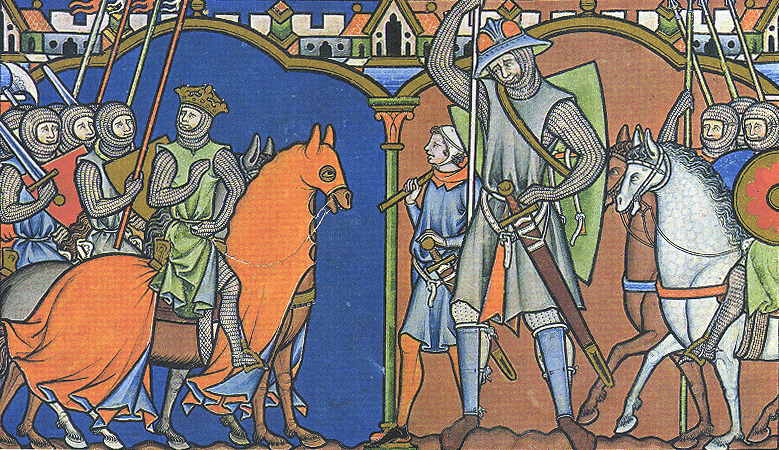
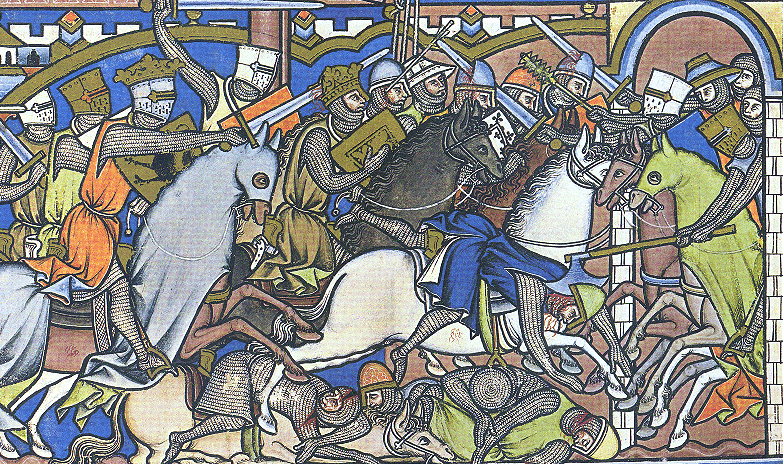
I think I've seen one something that could look like horse mail in Maciejowski Bible.. Countless other pieces of art show "bare" horses.
I can put more here, there's quite a lot of depictions of horses from medieval in the Net. So maybe later if I will have time.Last edited by Spiryt; 2010-07-29 at 11:26 AM.
Avatar by KwarkpuddingThe subtle tongue, the sophist guile, they fail when the broadswords sing;
Rush in and die, dogs—I was a man before I was a king.
Whoever makes shoddy beer, shall be thrown into manure - town law from Gdańsk, XIth century.
-
2010-07-29, 11:50 AM (ISO 8601)Banned

- Join Date
- Jul 2010
 Re: Got a Real-World Weapon or Armor Question? Mk. VI
Re: Got a Real-World Weapon or Armor Question? Mk. VI
Knights were the [heavy/assault] tanks of their day though [Massive shock and awe value, mobile, heavily armoured], and longbows were the machineguns.
A wall of steel and points coming towards you, making the ground shake was historically enough to break many less-ordered or already demoralised infantry formations. If they don't break; just halt the charge and pick on a less disciplined mob. Heavy cavalry kills stuff. Light cavalry pursues.
A long enough lanced formation, put up against infantry not equipped with spears is going to make a mess. Charging an ordered spear-line is obviously a very, veryFrenchstupid thing to do.
Additionally, Hastings didn't really feature couched lance charges. The Normans were using hit-and-wheel attacks, thrown spears and repeated probes. A couched lance charge wouldn't have worked either, but it's not a very fair comparison.
That totally depends on the era and doctrine in use at the time. Someone else has already cited the KV-1. Frontal assault was precisely what the heavies were for.In fact it's funny you mention tanks. Tanks were not, by doctrine, supposed to be used for shock attacks or breakthrough, they were intended for exploitation and destruction of an enemy whose lines had already broken, but of course hey were also used in the shock / breakthrough role.
They weren't small, either. Especially considering the size of the riders. And I obviously didn't mean hobs and rouncies. Put a wounded, thrashing destrier into a dense formation, and there's your gap to exploit, right there.Finally on the horses. Medieval cavalry horses were not huge.Last edited by Psyx; 2010-07-29 at 11:51 AM.
-
2010-07-29, 12:05 PM (ISO 8601)Titan in the Playground


- Join Date
- Feb 2006
- Location
- Kanagawa, Japan
- Gender

 Re: Got a Real-World Weapon or Armor Question? Mk. VI
Re: Got a Real-World Weapon or Armor Question? Mk. VI
Quite so.
As I understand it, these sort of combinations of light foot and horse was fairly common practice from at least the Punic Wars onwards for a few centuries, and may have been a reaction to a lack of sufficient cavalry.
Yes, indeed, and at Crecy and Agincourt the advantage was similar, in that the English commander chose the proper ground in which to engage. The Romans similarly made good use of defensive works, whether natural or man made, to put their infantry at the best advantage. Caesar has some choice things to say about sending his veterans to attack uphill, I seem to recall.
Definitely; if infantry are caught out in the open and are inclined to run, they may turn and run pretty early on (if not before contact).
Well, as far as is usefully possible.
Definitely. Arguably, the appearance of increasingly effective infantry formations may have been further prompted by increasingly effective heavy cavalry. From the twelfth century onwards not only the method of cavalry use, but arms they used was undergoing significant transformation from previous centuries.
Yes, indeed. And even in the early twelfth century combined arms was the thing. As I mentioned above, I have recently been reading Guibert of Nogent, who mentions "bowmen and lancers, who customarily march in front of the troops of foot-soldiers", suggesting either some sort of bow armed light cavalry (not too likely, but not impossible either) or else light foot. This situation at the beginning of the twelfth century seems to contrast with the organisation of Richard's forces at the end.
Very likely, indeed. The Andalusian is thought to be the closest modern analogue, from what I gather. What I have not seen much in the way of commentary regarding is the tendency of crusaders to replace their lost horses with local breeds. Were these the horses bred for the Turkish heavy cavalry, or the more common lighter horses? The crusaders themselves seem to draw no distinction, which is very odd.
Horse armour varies by over time. Prior to the twelfth century in the medieval period it was pretty rare, though it is mentioned as a sort of "standard" gear expected of a knight in late twelfth century poetry (Chrétien de Troyes, I think it was). It gradually increases in use after that, even full mail appearing on some illustrations (usually kings, dukes, et cetera). However, the Byzantine Empire may have preserved the general tendency to some degree, so it probably never completely disappeared. The big disadvantage is tiring the horse out, so armoured horse has to be very carefully used.
These sort of analogies are highly misleading. Tanks and knights are apples and pears. Knights are knights, tanks are tanks. Drawing parallels just muddies the water.
It no doubt happened, but when? That is really the issue. Battles were surprisingly rare in the medieval period, and accounts of precisely what occurred very thin on the ground. When there is real fighting to be done, you are as likely to see knights dismounting as charging into the fray (as at the Battle of the Standard).
Of course, but what kind of infantry fights without spears or pole arms of some sort? Bowmen, basically.
Well, they used a number of tactics in all probability. We certainly see post dated visual evidence for a couched lance on the tapestry, as well as thrown spears. Hastings is a pretty early example, but it hardly stands alone. The bottom line is that heavy cavalry is nowhere near unstoppable, but it has the potential to be devastating if used correctly, and that generally does not mean charging headlong into an equivalent standard of infantry, which is going to vary depending on what sort of knights we are looking at.
Possibly, but again when did that happen? If we look at examples of cavalry being turned away by infantry it seems to involve a lot of dead and wounded horses. More likely these were quickly dispatched, or caused as much trouble to the attackers as the defenders.Last edited by Matthew; 2010-07-29 at 12:22 PM.
It is a joyful thing indeed to hold intimate converse with a man after one’s own heart, chatting without reserve about things of interest or the fleeting topics of the world; but such, alas, are few and far between.
– Yoshida Kenko (1283-1350), Tsurezure-Gusa (1340)
-
2010-07-29, 12:05 PM (ISO 8601)Dwarf in the Playground

- Join Date
- Aug 2005
- Location
- Glasgow, Scotland
- Gender

 Re: Got a Real-World Weapon or Armor Question? Mk. VI
Re: Got a Real-World Weapon or Armor Question? Mk. VI
While I agree with Bennet's assessments by and large he does make some disagreeable claims. First he makes the mistake of thinking that horses will not charge into or over men or a wall of pikes. It is quite possible to train horses to do such suicidal things, and indeed it is impossible to explain how Edward I's knights received so many casualties from the immobile schiltrons at Falkirk unless this is possible. Indeed, at the time of fully armoured horse and rider, in the 16th century, there is one excellent example of horses charging into and through pike squares at Dreux in 1562. There are also impressive, but lesser examples at Ravenna in 1512 and Ceresole in 1544.
Second he makes the throwaway claim that the prime purpose of the couched lance was to dismount an opponent and make him yield to ransom. This is both unverifiable and rather strange, as in instances when killing an opponent was preferable to ransom, on Crusade for example, the lance was still the preferred weapon of the knight, not the sword.
Last he makes another unsupported claim that cavalry was 'often' dismounted for it to fight better. First "often" is not, in fact, very often until the Hundred Years' War, and even after this it is a rarity on the continent. Prior to this it was almost exclusively practiced in Norman-controlled areas, and only until the late 12th century. While he follows this on pointing out that mounted men are more capable of flight, he also does not explain how it makes the knights, fight 'better'.
It is worth mentioning that cavalry had a huge advantage in the much smaller engagements that took place during the ravaging of the countryside in early-high medieval warfare (1000-1200). It was in one of these engagements that Robert of Belleme captured Helias of Maine in a cleverly baited ambush. In these engagements you would have knights and infantry, probably arranged around the conroi and thus less than 100 men total (I would guess around 20 typically), who would operate semi-independently of one another. There would usually be similar parties arranged by the defenders to delay or prevent the ravaging, thus starving the invading force.
-
2010-07-29, 12:10 PM (ISO 8601)Ogre in the Playground

- Join Date
- Oct 2009
- Gender

 Re: Got a Real-World Weapon or Armor Question? Mk. VI
Re: Got a Real-World Weapon or Armor Question? Mk. VI
Maciejowski Bible is great but it depicts many things we don't find realistic, like swords cutting through helmets.
Until about 1250 AD in Europe, horse armor was mostly textile and cuir boulli. After 1250 mail and brigandine type armor increasingly reinforced the textile (which is itself armor). From this period, both in artwork and surviving artefacts, we see many examples of champrons (head armor for horses), Crinier (neck armor), Croupiere, and Peytrals (chest). By the early 1300s some kind of rigid horse armor was almost universal for knights.
Note images on pages 149-154 for several depictions of European horse armor from 1280s through the 1420s.
http://www.archive.org/stream/record...e/154/mode/2up
I'll post some more images later.
G.
-
2010-07-29, 12:12 PM (ISO 8601)Banned

- Join Date
- Jul 2010
 Re: Got a Real-World Weapon or Armor Question? Mk. VI
Re: Got a Real-World Weapon or Armor Question? Mk. VI
"Second he makes the throwaway claim that the prime purpose of the couched lance was to dismount an opponent and make him yield to ransom. "
I have never heard anything so absurd.
-
2010-07-29, 12:18 PM (ISO 8601)Ogre in the Playground

- Join Date
- Oct 2009
- Gender

 Re: Got a Real-World Weapon or Armor Question? Mk. VI
Re: Got a Real-World Weapon or Armor Question? Mk. VI
In support of your point, Usamah Ibn Munqidh points out that he observed that couched lance was necessary to pierce mail, holding the lance any other way would not deliver a sufficiently hard blow to punch through.
I think this is a classic example that we see over and over and over in English language historical analysis most accessible to American readers (usually from the UK) that conflates conditions in Britain, and to a lesser extent France (though an English lens) with that of Europe in general, whether on a political, military, or cultural level. This is a big mistake with regard to the History of pre industrial Europe particularly during the Renaissance.Last he makes another unsupported claim that cavalry was 'often' dismounted for it to fight better. First "often" is not, in fact, very often until the Hundred Years' War, and even after this it is a rarity on the continent.
Though that said the importance of heavy infantry is often ignored in these discussions, they were not dismounted knights typically but heavy infantry became increasingly important in Europe from the 14th Century.
Most warfare in Medieval times consisted of small raids and sieges. Like border reiver warfare in Scotland.It is worth mentioning that cavalry had a huge advantage in the much smaller engagements that took place during the ravaging of the countryside in early-high medieval warfare (1000-1200). It was in one of these engagements that Robert of Belleme captured Helias of Maine in a cleverly baited ambush. In these engagements you would have knights and infantry, probably arranged around the conroi and thus less than 100 men total (I would guess around 20 typically), who would operate semi-independently of one another. There would usually be similar parties arranged by the defenders to delay or prevent the ravaging, thus starving the invading force.
G.
-
2010-07-29, 12:36 PM (ISO 8601)Titan in the Playground


- Join Date
- Feb 2006
- Location
- Kanagawa, Japan
- Gender

 Re: Got a Real-World Weapon or Armor Question? Mk. VI
Re: Got a Real-World Weapon or Armor Question? Mk. VI
I agree with you there, but will also add that its not a cost effective use of such cavalry. Looking at his article, I will point out that what he seems to be driving at is that the war horse will not simply steamroller through infantry crushing everything in its path, but he has probably overstated the case (given we are talking about p. 33). His example of the Muslim militia facing off against cavalry certainly implies considerable hand-to-hand fighting between cavalry and infantry.
I think you may have misread this line, he refers to jousting, not the battlefield function (p. 36). Presumably he has in mind the tournament, from which swords were barred for use, though he does seem to have conflated his point with a particular battlefield encounter. [edit] Huh, reading it again it does look like he is implying that lances were not used on the battlefield when "serious" fighting was to be done; very strange. If I get the opportunity, I will ask him about it, as I have not heard him say as much elsewhere.
Well, "often" is certainly subjective, but let us not get caught up on "fight better" as this is clearly circumstantial. Presumably, what is being asserted here is that they will contribute more effectively to the battle by being dismounted, and thus "fight better". Were it felt they would contribute better horsed, then surely they would have remained mounted. I will confess to being ignorant of a great many French battles, but in Germany it was apparently common enough for knights to dismount and fight afoot, even to the point that William of Tyre commented when Conrad III did so outside Damascus that it was the "usual" practice of the Germans in a crisis:
Enraged at this news, Conrad with his knights galloped swiftly forward through the king's lines and reached the fighters who were trying to win the river. Here all leaped down from their horses and became foot soldiers, as is the custom of the Teutons when a desperate crisis occurs. Holding their shields before them, they engaged the enemy in a hand-to-hand fight with swords. The Damascenes at first resisted bravely, but soon, unable to sustain the onslaught, they abandoned the river and fled to the city with all possible haste.
Certainly.
Indeed; I do wonder about that paragraph now Edmund has pointed it out. I think it may not convey the author's intent quite exactly (since he cites the exact passage you just did right before it).
Generalisation is a problem, but we need not look too far for non-Norman examples of dismounted knights.
Not under ideal circumstances, certainly.Last edited by Matthew; 2010-07-29 at 04:18 PM.
It is a joyful thing indeed to hold intimate converse with a man after one’s own heart, chatting without reserve about things of interest or the fleeting topics of the world; but such, alas, are few and far between.
– Yoshida Kenko (1283-1350), Tsurezure-Gusa (1340)
-
2010-07-29, 12:55 PM (ISO 8601)Troll in the Playground


- Join Date
- Feb 2005
- Gender

 Re: Got a Real-World Weapon or Armor Question? Mk. VI
Re: Got a Real-World Weapon or Armor Question? Mk. VI
Okay, here's a question... what materials were the poles of pole arms generally made from in different areas? In China and Japan? In Europe?
JaronK
-
2010-07-29, 02:32 PM (ISO 8601)Firbolg in the Playground

- Join Date
- Sep 2009
- Location
- Where ever trouble brews
- Gender

 Re: Got a Real-World Weapon or Armor Question? Mk. VI
Re: Got a Real-World Weapon or Armor Question? Mk. VI
European Sword Fighting, 600-1399. We don't do rank and file, because we don't have enough bodies. Most of our fighting stays 1 on 1, the most it ever gets is 4 on 4 or decent melee's. I teach our fighters to use other people as terrain pieces if possible, especially if outnumbered. Subsequently I do my best to teach people to avoid becoming interferances for their team mates unless being a meat shield is their intended strategy, such as when one is carrying a shield and another is not.
Typically shield walls do not form in these particular combats, as it is too easy for someone to slip behind one, or split the focus and strike from multiple angles.~~Courage is not the lack of fear~~
"In soviet dungeon, aboleth farms you!"
"Please consult your DM before administering Steve brand Aboleth Mucus.
Ask your DM if Aboleth Mucus is right for you.
Side effects include coughing, sneezing, and other flu like symptoms, cancer, breathing water like a fish, loss of dignity, loss of balance, loss of bowel and bladder control."
-
2010-07-29, 03:49 PM (ISO 8601)Ogre in the Playground

- Join Date
- Oct 2009
- Gender

 Re: Got a Real-World Weapon or Armor Question? Mk. VI
Re: Got a Real-World Weapon or Armor Question? Mk. VI
Rigid horse armor from 1330's (some covered by caprison some uncovered)

G.
-
2010-07-29, 07:44 PM (ISO 8601)Banned

- Join Date
- Jun 2010
- Location
- Beyond Poisonthorn Acre
 Re: Got a Real-World Weapon or Armor Question? Mk. VI
Re: Got a Real-World Weapon or Armor Question? Mk. VI
I would venture that it was almost universally wood, since an iron haft would be something like 10-20 times as heavy and pretty ridiculously unwieldy (if I recall right that wood densities tend to be less than 1 kilogram/cubic meter), and wood is much easier to come by and work.
-
2010-07-29, 09:21 PM (ISO 8601)Ogre in the Playground

- Join Date
- Sep 2008
-
2010-07-30, 12:16 AM (ISO 8601)Troll in the Playground


- Join Date
- Feb 2005
- Gender

 Re: Got a Real-World Weapon or Armor Question? Mk. VI
Re: Got a Real-World Weapon or Armor Question? Mk. VI
I'm looking for something more specific, I'm actually making one.
JaronK
-
2010-07-30, 03:41 AM (ISO 8601)Halfling in the Playground

- Join Date
- Nov 2008
- Gender

 Re: Got a Real-World Weapon or Armor Question? Mk. VI
Re: Got a Real-World Weapon or Armor Question? Mk. VI
Ash was popular in the European region. It's resilient, elastic and hard, and it's a pretty straight grained wood.
http://www.armor.com/pole118.html
-
2010-07-30, 02:04 PM (ISO 8601)Ogre in the Playground

- Join Date
- Oct 2009
- Gender

 Re: Got a Real-World Weapon or Armor Question? Mk. VI
Re: Got a Real-World Weapon or Armor Question? Mk. VI
Some more early depictions of horse armor:
the Holkham Picture Bible of c.1330:

Circa 1380

Circa 1400

G.Last edited by Galloglaich; 2010-07-30 at 02:06 PM.
-
2010-07-30, 02:42 PM (ISO 8601)Titan in the Playground


- Join Date
- Feb 2006
- Location
- Kanagawa, Japan
- Gender

 Re: Got a Real-World Weapon or Armor Question? Mk. VI
Re: Got a Real-World Weapon or Armor Question? Mk. VI
Here are some others:
Spoiler
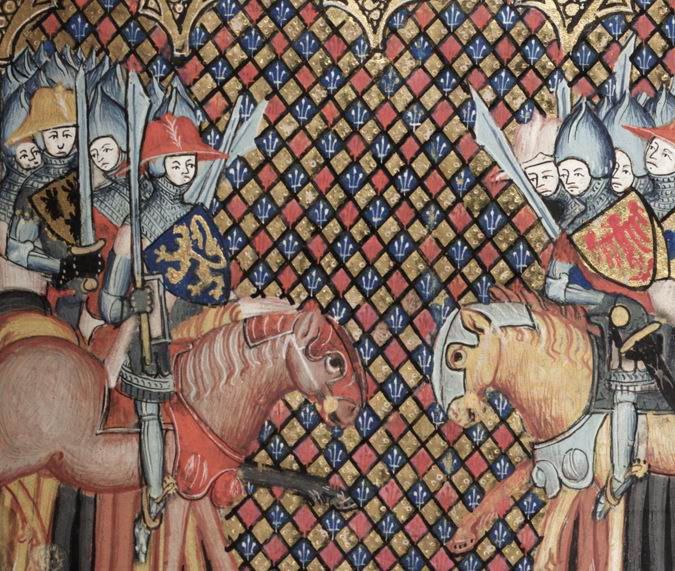
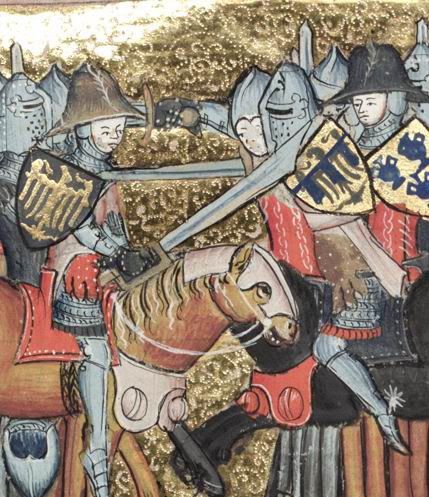
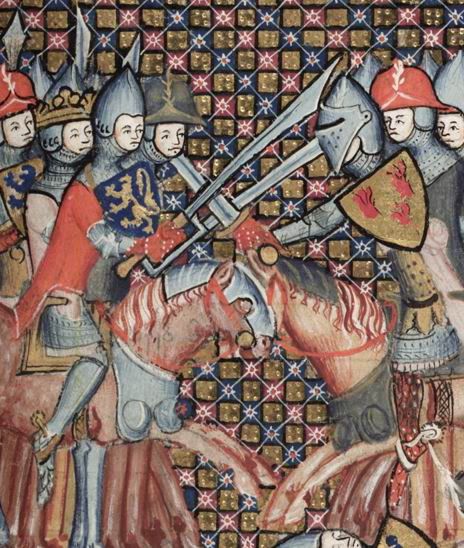
But my favourite is actually on the front and back of Medieval Knighthood V (scroll down to the bottom for the rear cover). I do not have a copy to hand, but I seem to recall those images of fully mail barded warhorses being from a thirteenth century manuscript.It is a joyful thing indeed to hold intimate converse with a man after one’s own heart, chatting without reserve about things of interest or the fleeting topics of the world; but such, alas, are few and far between.
– Yoshida Kenko (1283-1350), Tsurezure-Gusa (1340)
-
2010-07-31, 01:34 AM (ISO 8601)Titan in the Playground


- Join Date
- Aug 2009
- Location
- Maryland
- Gender

 Re: Got a Real-World Weapon or Armor Question? Mk. VI
Re: Got a Real-World Weapon or Armor Question? Mk. VI
There is the fact that unhorsing a knight did limit him quite a bit...and as he was rather unlikely to land on his feet, he was at a marked disadvantage. Getting a one hit kill on a well trained, fully armored knight is rather unlikely, but once slammed to the ground, they could get mobbed, trampled, etc. Plenty of knights in battlefield graves bear relatively little injury to their bones, and likely died of a number of soft tissue injuries. Messy, but effective. I suspect that the same reasons a lance was good for collecting ransoms also made it an excellent choice in other situations as well.
Plus, of course, there's the range issue with a lance vs say, a sword.
-
2010-07-31, 08:05 AM (ISO 8601)Ogre in the Playground

- Join Date
- Oct 2009
- Gender

 Re: Got a Real-World Weapon or Armor Question? Mk. VI
Re: Got a Real-World Weapon or Armor Question? Mk. VI
-
2010-08-01, 07:41 AM (ISO 8601)Banned


- Join Date
- Jul 2010
- Location
- I'm all in your mind...
- Gender

 Re: Got a Real-World Weapon or Armor Question? Mk. VI
Re: Got a Real-World Weapon or Armor Question? Mk. VI
Against an enemy on horseback or foot really, spears were effective. They could cut or stab, could be thrown, could be used with almost no training, and didn't require that you had much strength to use them. A sword required you add the strength of your arm to the blow, the spear required little power and went right in.
-
2010-08-01, 12:01 PM (ISO 8601)Bugbear in the Playground


- Join Date
- May 2010
 Re: Got a Real-World Weapon or Armor Question? Mk. VI
Re: Got a Real-World Weapon or Armor Question? Mk. VI
A spear requires just as much strength to push it into someone as a sword does, assuming equivalent blade geometry. A spear with a pointy spike at the tip will pierce as easily as a sword with the same shape (such as an estoc/tuck) and a spear with a flat broad head will pierce and slice like a sword with the same shape. You can't fight physics. A spear just seems easier sometimes because you use two hands and you can get more leverage on the longer haft.
And to clear up some myths from the thread Roland just closed:
A .50 bullet will not hurt you even with a near miss because of the shockwave around the bullet. A bullet will never hurt you without touching you. The lack of destructive shockwave is clear from paper targets. The holes in the paper are the same size as the bullets and there's no additional damage from the disrupted air around the bullet.
-
2010-08-01, 12:10 PM (ISO 8601)Ettin in the Playground


- Join Date
- Jun 2006
- Location
- Poland
- Gender

 Re: Got a Real-World Weapon or Armor Question? Mk. VI
Re: Got a Real-World Weapon or Armor Question? Mk. VI
But they usually won't have the same geometry, as spear would have much shorter blade than most swords, and in result it would have geometry as a part of the sword blade at most.
They would be much stiffer in majority of causes, as well as more 'dead' harmonically.
All in all I would say that there indeed would be mechanical advantage in case of penetration, with also good leverage of haft, compared to even more heavy, due to length blade mounted as a sword.
Although more importantly it would just behave differently.Last edited by Spiryt; 2010-08-01 at 12:11 PM.
Avatar by KwarkpuddingThe subtle tongue, the sophist guile, they fail when the broadswords sing;
Rush in and die, dogs—I was a man before I was a king.
Whoever makes shoddy beer, shall be thrown into manure - town law from Gdańsk, XIth century.
-
2010-08-01, 08:22 PM (ISO 8601)Titan in the Playground


- Join Date
- Feb 2006
- Location
- Kanagawa, Japan
- Gender

 Re: Got a Real-World Weapon or Armor Question? Mk. VI
Re: Got a Real-World Weapon or Armor Question? Mk. VI
Referring back to the heavy cavalry question, there is some good discussion as to infantry and cavalry tactics available to read in the Google preview for Adrian Goldsworthy's The Roman Army at War: 100 BC to 200 AD.
Last edited by Matthew; 2010-08-01 at 08:22 PM.
It is a joyful thing indeed to hold intimate converse with a man after one’s own heart, chatting without reserve about things of interest or the fleeting topics of the world; but such, alas, are few and far between.
– Yoshida Kenko (1283-1350), Tsurezure-Gusa (1340)










 RSS Feeds:
RSS Feeds: 

